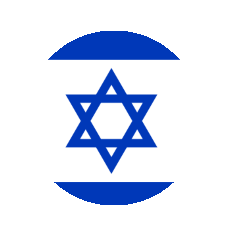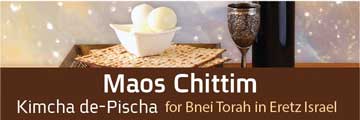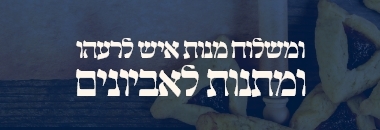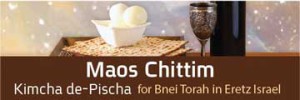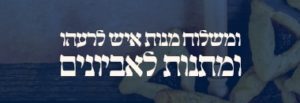Rebbi started the Shiur with the question that he ended of last year’s Shiur on Parshas Vayeishev.
37:14 Yaakov sends Yosef to his brothers at it says in the Posuk, לֶךְ-נָא רְאֵה אֶת-שְׁלוֹם אַחֶיךָ וְאֶת-שְׁלוֹם הַצֹּאן
The Pashtus is that the brothers were in Shechem which was a dangerous place and Yaakov wanted to know how they are doing. However there is a problem because Rashi on 37:29 tells us that Reuvein who had been there when the brothers decided to do away with Yosef, as he was the one who suggested to throw Yosef in the Boir. It says in the Posuk, וַיָּשָׁב רְאוּבֵן אֶל-הַבּוֹר, וְהִנֵּה אֵין-יוֹסֵף בַּבּוֹר
Where was Reuvein?
Rashi says (וישב ראובן: ובמכירתו לא היה שם, שהגיע יומו לילך ולשמש את אביו. דבר אחר עסוק היה בשקו ובתעניתו על שבלבל יצועי אביו) that Reuvein was not present when Yosef was sold, for his turn had arrived to go to attend to his Father Yaakov. So it comes out that the brothers took turns going to their Father every day. So if every one of the brothers went to attend to their Father and then returned to the brothers, why was Yosef sent to see after the well-being of his brothers, Yaakov could have gotten the regards from the brother who was coming back each and every day?
The Torah Temimah explains as follows. Yaakov didn’t send Yosef to find out how the brothers are doing which is certainly Pashut Pshat. He sent Yosef to the brothers with the following plan.
Yaakov knew that Yosef was complaining that the brothers were Mizalzel in the Bnei Hashfachos, that they don’t treat those Shevatim that are children of the Shfochos well. In addition, they eat Eiver Min Hachai. He told Yosef to (רְאֵה אֶת-שְׁלוֹם אַחֶיךָ וְאֶת-שְׁלוֹם הַצֹּאן). Meaning, you will see how they are behaving, they are not mistreating the Bnei Hashfochos. Also, look at Shlom Hatzon you will see that the Tzon are complete and that the Shevatim are not eating Eiver Min Hachai. That was the true reason that he sent them. This is an interesting Drush as a Teretz.
38:11 ( וַיֹּאמֶר יְהוּדָה לְתָמָר כַּלָּתוֹ שְׁבִי אַלְמָנָה בֵית-אָבִיךְ, עַד-יִגְדַּל שֵׁלָה בְנִי–כִּי אָמַר, פֶּן-יָמוּת גַּם-הוּא כְּאֶחָיו; וַתֵּלֶךְ תָּמָר, וַתֵּשֶׁב בֵּית אָבִיהָ) We find Yehuda saying to Tamar that wait (עַד-יִגְדַּל שֵׁלָה בְנִי). Tamar had been married to Er and Onan and each had died and Yehuda said I will not give you my 3rd son until he gets older. Rashi says that (כי אמר וגו’: כלומר דוחה היה אותה בקש, שלא היה בדעתו להשיאה לו). Meaning, Yehuda was disingenuous, that he wasn’t being honest. Yehuda said, Tamar, 2 of your husband’s died, you are a Katlanus, a twice widowed woman. Therefore, in Yehuda’s mind he was not going to give Shaila to Tamar, because she was a Katlanus and she was no longer entitled to marry somebody.
There are obvious difficulties here. The Ramban points out a question on Rashi, why didn’t Yehuda tell the truth to Shaila. If Yehuda really wasn’t going to give Shaila to Tamar he should have told the reason to Shaila and Tamar?
Secondly, why didn’t they do Chalitzah? If there is a Mitzvah of Yibum and apparently they kept Yibum why not do Chalitzah?
In Maseches Yevomas we find that many Poskin discuss the question of; is Chalizah a Mitzvah (like Lulav is a Mitzvah and we take a Lulav no matter what) or is Chalitzah a Matir (something that permits a person to eat meat like Shechitah). Shechitah is not a Mitzvah it is a Matir. If Chalitzah is a Matir, then there is no reason why this woman should have a Chalitzah performed because she doesn’t plan on getting remarried. If a person did not want or did not desire to eat meat, he would not Shect. Shechita is a Matir, it allows the meat to be eaten. We can learn that Chalitzah is a Matir and not a Mitzvah. As a Matir it is only a Mitzvah if she wants to remarry. If she doesn’t want to remarry then there is no Mitzvah.
So is Chalizah a Mitzvah (like Lulav is a Mitzvah and we take a Lulav no matter what) or is Chalitzah a Matir (something that permits a person to eat meat like Shechitah)?
The Nafka Mina is let’s say the woman will not get remarried for whatever reason (she is older already), is there any purpose of her doing Chalizah? Do we say to her that just like there is a Mitzvah to shake a Lulav so to there is a Mitzvah to do Chalitzah and she should do Chalitzah anyway, or do we say Chalitzah is a Matir and there is no reason to do something that is a Matir?
There are 3 Gedolei Achronim that hold that Chalitzah is only a Matir. They are the Node B’yehuda, Chasam Sofer, and Rav Yitzchok Elchonon. They all say that if a woman does not want to remarry she does not have to do Chalitzah.
The Chasam Sofer brings that Al Pi Kabbalah there is an Inyan to do it anyhow, however, it is not an obligation. Therefore, it is only a Matir. The Netziv in Hameik Shaila argues vehemently and brings what seems to be excellent Rayos that indeed it is a Mitzvah. We are not coming to Pasken now. We are dealing with the Node B’yehuda.
The Node B’yehuda says that Chalitzah is only a Matir. If you don’t plan to remarry there is no need to do Chalitzah. Says the Node B’yehuda very Geshmak about Shaila, why didn’t Shaila do Chalitzah? Since Tamar was a Katlanus anyway and could not remarry, and a woman who can’t remarry has no need for Chalitzah, because the Node B’yehuda maintains L’shitoso that Chalitzah is only a Matir. Therefore, if there is no plans to remarry then there is no reason to do Chalitzah. So that answers at least one question, the question of why didn’t they do Chalitzah.
The Node B’yehuda says that a Katlanus falling to Yibum can do Yibum. Although marrying a Katlanus is a Sakanah, however, there is a concept of Shomer Mitzvah Lo Yeida Davar Ra. Yibum is a Dvar Mitzvah and therefore, a person can do Yibum with someone who is a Katlanus.
If so, why didn’t Shaila marry Tamar? The Halacha is that a Koton can’t do Yibum because we still don’t know if he will be a normal adult male capable of having children because if he is a Saris then he is not eligible for Yibum. So Yehuda did tell Tamar the truth, he said (עַד-יִגְדַּל שֵׁלָה בְנִי) wait until Shaila gets older and as Rashi says Tamar was a Katlanus so Yehuda had no plans for Shaila to marry her unless he grows up and has Shtei Saros and it becomes clear that it is a Mitzvah and at that time you could do Yibum.
It is a very Geshmake Node B’yehuda on two fronts. On the Chalitzah front and on the Yibum front.
A thought regarding Chanukah. It is very important to take something before Chanukah to work on. Chanukah is a time that Melachah is Muttar, most people go to work on Chanukah and on their day off on Sunday they are busy with beautiful family get togethers. Therefore, it is easy for Chanukah to pass without a person taking note.
The main Yesod of the Chanukah observance is Chanukas Bais Hamikdash. The fact that the Avodah in the Bais Hamikdash was reintroduced and done so in a very beautiful Oifen (way). Therefore, it seems to me that Chanukah should be a time to work on our Avoda, on our Tefillah. Making a Chanukas Hamikdash and strengthening our Davening. The Bakashas Tzrochim (asking for things) during Davening is something that we do well. However, Avodah, attributing everything to Hashem should be a job of the Chanukah Davening.
There are a number of unusual things about Al Hanisim. Al Hanisim is unusual in where it is placed. As you know on Yomim Tovim or Rosh Chodesh we put it in a different Beracha. Here by Al Hanisim we put it into Modim. The same thing by Bentching. Both Shabbos, Yomim Tovim, and even Rosh Chodesh have additions that are added in one spot and Al Hanisim is added in a different place. This is the major difference between Al Hanisim and any other time we mention a special occasion.
There are a number of additional differences, but by explaining this all the additional differences will become clear.
There is a major difference between Al Hanisim and the other times that we mention a holiday. The other times that we mention a holiday, we are doing so just for that reason, to mention that it is a Yom Tov. We ask a Bakashah based on the Yom Tov, Zachreinu in Yaale V’yavo etc. It has nothing to do with Al Hanisim. Al Hanisim is a Tefillah purely for giving thanks. We thank the Ribbono Shel Olam for the Nissim that have occurred. In Al Hanisim we relate the story of what happened during Chanukah and Purim. In Yaale V’yavo we don’t relate the story of Pesach, Shevuos, and Sukkos.
The answer is this is different. It is a time to give thanks to the Ribbono Shel Olam. There is a big Pilpul on why is there no Al Hanisim in Al Hamichya. The other Yomim Tovim are mentioned in Al Hamichya. However, according to what is being said, it is beautiful. Bentching has Node L’chha, a Bracha for Hoda’a a place to add Al Hanisim. Al Hamichya has no corresponding section of Hoda’a. Even the part that is K’negged the second Bracha of Benthching we only say Aretz and there are no expressions of Hoda’a (thanks), therefore Al Hanisim has no place in the Bracha of Al Hamichya.
There is another difference, if one forgets Al Hanisim, he is allowed to add it in the Harachamans in the end. The Shulchan Aruch in Taf Reish Pei Beis says if you forgot Al Hanisim, when you get to the Harachamans, you can add it later.
If you forget Ritzei or Yaaleh V’yavo there is no makeup Harachaman. You can’t add it later? Al Hanisim is Hoda’a and it happens to be that there is a second part of Bentching that has Hoda’a mentioned. Therefore, you can add it later.
You see that when you understand the Yesod (reason) for Al Hanisim that it is a concept of Hoda’a then the various questions and differences that come up are differences that are easily understood.
If one forgot Ritzei or Yaale V’yavo in Bentching there is a Bracha to be made between Bonei Yerushalayim and the next Bracha. On Chanukah and Purim there is no such Bracha. You can’t say that it is not Miakeiv if you don’t say Al Hanisim because it is not Miakeiv if you forget Yaaleh V’yavo on Rosh Chodesh either. Yet there is a Bracha that is added. Why is there no such Bracha for Al Hanisim?
The reason is that Al Hanisim can only be added as a part of Hoda’a and not in a place that is not a section of Hoda’a. The message of course is that the concept of Al Hanisim is a recognition that everything comes from the Borei Olam which is the Avoda of Davening and the part of Davening that is the crucial piece of Davening. Perhaps, an appreciation of Al Hanisim will help us be able to be Mechavein in Shemoneh Esrei to thank the Borei Olam who guides us through this very long Galus B’rachamav Horabim. I hope you all have a wonderful and meaningful Chanukah.

